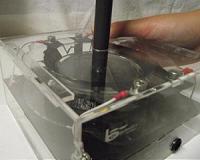 |
Washington DC (SPX) Apr 20, 2011 Scientists at the NRL Materials Science and Technology Division are providing solid evidence that there is a new route towards developing novel, lightweight energy storage devices. By moving away from centuries of caustic, hazardous aqueous-based battery cells and instead using non-volatile, thermally-stable ionic liquids, scientists predict multiple new types of batteries. Rather than depend on highly acidic electrolytes, ionic liquids are used to create a solid polymer electrolyte composed of an ionic liquid and polyvinyl alcohol, developing novel types of solid state batteries with discharge voltages ranging up to 1.8 volts. The unique properties of ionic liquids have fostered this explosive interest in battery applications. Ionic liquids are room temperature molten salts that possess many important characteristics, such as nearly no vapor pressure, non- flammability and lack of reactivity in various electrochemical or industrial applications. "It is the high thermal and electrochemical stability of the ionic liquids which has fostered the growing interest in ionic liquids for use in various electrochemical processes," said Dr. Thomas Sutto. "These new types of solid-state cells mimic standard alkaline cells, but without the need for caustic electrolytes." Limits imposed by using corrosive electrolytes often result in severe restrictions to standard battery geometry and the need for special corrosive-resistant battery containers. The use of reactive ionic liquids in non-aqueous cells replaces the more hazardous highly alkaline electrolytes such as manganese oxide (MgO) and zinc (Zn) found in traditional batteries. The root of this work began during standard corrosion studies of different metals in ionic liquids. While working with ionic liquids based on mineral acids, such as hydrogen sulphates, it was observed that Zn metal would react to form zinc sulphate. Since this is similar to that observed for the zinc anode in a standard alkaline cell, a series of experiments were then performed to determine how different metal oxides reacted in these types of ionic liquids. Electrochemical experiments demonstrate that not only can these reactive ionic liquids act as the electrolyte/separator in both solid state and liquid batteries, but they can also act as a reactive species in the cell's electrochemical makeup. Using a non-aqueous approach to primary and secondary power sources, batteries are designed using standard cathode and anode materials such as magnesium dioxide (MgO2), lead dioxide (PbO2) and silver oxide (AgO). The ionic liquid that is the main focus of this work is 1-ethyl-3-methylimidazolium hydrogen sulphate (EMIHSO4), however, other ionic liquids such as those based on the nitrate and dihydrogen phosphate anions (negatively charged ions) have also been found to work well in this type of a battery design. The use of these electrolytes suggests the potential for new types of rechargeable systems, such as replacement electrolytes in nickel-metal hydride (NiMH) batteries, or even the standard lead-acid battery. Experimental work is currently underway to develop such a rechargeable ionic liquid power source. The ability to create solid separators also allows for the formation of many new types of batteries via a number of fabrication techniques.
Share This Article With Planet Earth
Related Links NRL Powering The World in the 21st Century at Energy-Daily.com
 Replacing Batteries May Become A Thing Of The Past, Thanks To Soft Generators
Replacing Batteries May Become A Thing Of The Past, Thanks To Soft GeneratorsWashington DC (SPX) Apr 11, 2011 Battery technology hasn't kept pace with advancements in portable electronics, but the race is on to fix this. One revolutionary concept being pursued by a team of researchers in New Zealand involves creating "wearable energy harvesters" capable of converting movement from humans or found in nature into battery power. A class of variable capacitor generators known as "dielectric elastomer ... read more |
|
| The content herein, unless otherwise known to be public domain, are Copyright 1995-2010 - SpaceDaily. AFP and UPI Wire Stories are copyright Agence France-Presse and United Press International. ESA Portal Reports are copyright European Space Agency. All NASA sourced material is public domain. Additional copyrights may apply in whole or part to other bona fide parties. Advertising does not imply endorsement,agreement or approval of any opinions, statements or information provided by SpaceDaily on any Web page published or hosted by SpaceDaily. Privacy Statement |